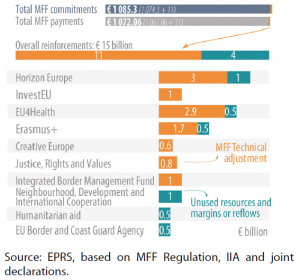During the years 2022 to 2027, the overall level of MFF resources will gradually increase to €1 085.3 billion for commitments (i.e. €2 billion more than the 2014-2020 MFF without the UK and including the EDF) and €1 072.1 billion for payments (2018 prices), thanks to a new article in the MFF Regulation negotiated by Parliament (see Section 3.4) that introduces annual upwards adjustments of the ceilings for subheading ‘2b. Resilience and Values’ (+€6 billion in total by 2027) and headings ‘1. Single Market, Innovation and Digital’ (€4 billion) and ‘4. Migration and Border Management’ (+€1 billion). These adjustments will start as of 2022 and be programme-specific, focusing on instruments with high European added value that Parliament identified as deserving further resources as compared to the European Council’s settlement of July 2020 (see Section 3.4). The financing of the total €11 billion reinforcement will be linked to revenue stemming from competition fines, in line with Parliament’s long-standing call for such revenue to finance the EU budget. The top-ups will go to flagship programmes providing EU common goods such as research, health, Erasmus+ and border management, based on an allocation key defined in the new Annex II of the MFF Regulation.
In addition, some of these programmes as well as other two instruments (the Neighbourhood, Development and International Cooperation Instrument and humanitarian aid) and Frontex (the EU Border and Coast Guard agency) will receive a further €4 billion from the re-use of de-committed funds for research (another recurrent demand from Parliament), reflows from predecessor instruments and unused margins (see Figure 22 for an overview of top-ups by instrument). These resources, some of which are already included in the adopted budget for 2021, do not lead to upward revisions of the ceilings.








Be the first to write a comment.